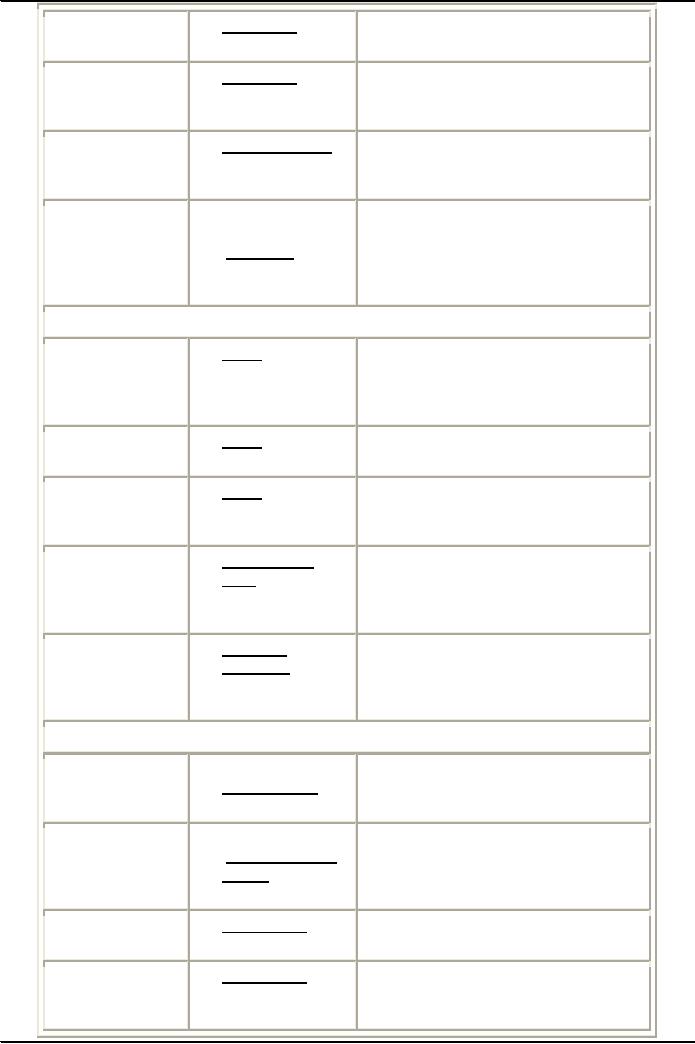 |

Strategic
Management MGT603
VU
Lesson
15
INTERNAL
ASSESSMENT
(FINANCE/ACCOUNTING)
Objectives:
Financial
condition is often considered the
single best measure of a firm's
competitive position
and
overall
attractiveness to investors. Determining
an organization's financial strengths
and weaknesses is
essential
to formulating strategies effectively. A
firm's liquidity, leverage, working
capital, profitability,
asset
utilization, cash flow, and
equity can eliminate some strategies as
being feasible alternatives.
Financial
factors often alter existing strategies
and change implementation
plans. After reading
this
lecture,
you will be able to know
that what are the basics
types of ratios and who
business measure its
financial
strength using these ratios
analysis.
Finance/Accounting
Functions
Determining
financial strengths and weaknesses
key to strategy
formulation
Investment
decision (Capital budgeting)
Financing
decision
Dividend
decision
According
to James Van Horne, the
functions
of finance/accounting comprise
three decisions: the
investment
decision, the financing decision,
and the dividend
decision.
Financial
ratio analysis is the most
widely used method for determining an
organization's strengths
and
weaknesses
in the investment, financing, and dividend
areas. Because, the functional
areas of business
are
so closely related, financial ratios
can signal strengths or
weaknesses in management,
marketing,
production,
research and development, and computer
information systems
activities.
The
investment
decision,
also
called capital
budgeting,
is the allocation
and reallocation of capital
and
resources to projects, products,
assets, and divisions of an organization.
Once strategies are
formulated,
capital budgeting decisions are required
to implement strategies successfully. The
financing
decision
concerns
determining the best capital structure
for the firm and includes
examining various
methods
by which the firm can raise
capital (for example, by
issuing stock, increasing debt,
selling
assets,
or using a combination of these
approaches). The financing
decision must consider both
short-
term
and long-term needs for
working capital. Two key
financial ratios that indicate whether a
firm's
financing
decisions have been effective
are the debt-to-equity ratio
and the debt-to-total-assets
ratio.
Dividend
decisions concern
issues such as the percentage of
earnings paid to stockholders, the
stability
of dividends paid over time, and the
repurchase or issuance of stock.
Dividend decisions
determine
the amount of funds that are retained in
a firm compared to the amount paid out
to
stockholders.
Three
financial ratios that are
helpful in evaluating a firm's dividend
decisions are the
earnings-per-
share
ratio, the dividends-per-share ratio,
and the price-earnings ratio.
The benefits of paying dividends
to
investors must be balanced
against the benefits of retaining funds internally,
and there is no set
formula
on how to balance this trade-off.
For the reasons listed here,
dividends are sometimes paid
out
even
when funds could be better reinvested in the business
or when the firm has to obtain
outside
sources
of capital:
1.
Paying cash dividends is customary.
Failure to do so could be thought of as a stigma. A
dividend
change
is considered a signal about the
future.
2.
Dividends represent a sales
point for investment bankers.
Some institutional investors
can buy only
dividend-paying
stocks.
3.
Shareholders often demand dividends,
even in companies with great
opportunities for reinvesting
all
available funds.
4.
A myth exists that paying dividends
will result in a higher stock
price.
Basic
Types of Financial Ratios
Financial
ratios are computed from an
organization's income statement
and balance sheet.
Computing
financial
ratios is like taking a picture
because the results reflect a situation at
just one point in
time.
Comparing
ratios over time and to
industry averages is more
likely to result in meaningful statistics
that
can
be used to identify and
evaluate strengths and
weaknesses. Trend analysis, illustrated
in Figure, is a
useful
technique that incorporates both the time
and industry average
dimensions of financial ratios.
64

Strategic
Management MGT603
VU
Table
provides a summary of key financial
ratios showing how each
ratio is calculated and what
each
ratio
measures. However, all the
ratios are not significant
for all industries and
companies. For
example,
accounts
receivable turnover and
average collection period
are not very meaningful to a company
that
does
primarily cash receipts
business. Key financial ratios
can be classified into the
following five types:
Liquidity
ratios measure
a firm's ability to meet maturing short-term
obligations. It includes:
Current
ratio
Quick
(or acid-test) ratio
Leverage
ratios measure
the extent to which a firm has
been financed by debt.
Debt-to-total-assets
ratio
Debt-to-equity
ratio
Long-term
debt-to-equity ratio
Times-interest-earned
(or coverage) ratio
Activity
ratios measure
how effectively a firm is
using its resources.
Inventory-turnover
Fixed
assets turnover
Total
assets turnover
Accounts
receivable turnover
Average
collection period
Profitability
ratios measure
management's overall effectiveness as
shown by the returns generated
on
sales
and investment.
Gross
profit margin
Operating
profit margin
Net
profit margin
Return
on total assets (ROA)
Return
on stockholders' equity
(ROE)
Earnings
per share
Price-earnings
ratio
Growth
ratios measure
the firm's ability to maintain its
economic position in the growth of
the
economy
and industry.
Sales
Net
income
Earnings
per share
Dividends
per share
A
Summary of Key Financial
Ratios
Ratio
How
Calculated
What
It Measures
Liquidity
Ratios
Current
Ratio
Current
assets
The
extent to which a firm can
meet its
Current
liabilities
short-term
obligations
Quick
Ratio
Current
assets
The
extent to which a firm can
meet its
minus
short-term
obligations without relying
inventory
upon
the sale of its inventories
Current
liabilities
Leverage
Ratios
65

Strategic
Management MGT603
VU
Debt-to-Total-
Total
debt
The
percentage of total funds that
are
Assets
Ratio
Total
assets
provided
by creditors
Debt-to-Equity
Total
debt
The
percentage of total funds
provided
Ratio
Total
stockholders'
by
creditors versus by
owners
equity
Long-Term
Long-term
debt
The
balance between debt and
equity
Debt-to-Equity
Total
stockholders'
in
a firm's long-term capital
structure
Ratio
equity
Times-Interest-
Profits
before
The
extent to which earnings
can
Earned
Ratio
interest
decline
without the firm
becoming
and
taxes
unable
to meet its annual interest
costs
Total
interest
charges
Activity
Ratios
Inventory
Sales
Whether
a firm holds excessive
stocks
Turnover
Inventory
of
of
inventories and whether a firm is
finished
goods
selling
its inventories slowly compared
to
the industry average
Fixed
Assets
Sales
Sales
productivity and plant
and
Turnover
Fixed
assets
equipment
utilization
Total
Assets
Sales
Whether
a firm is generating a
Turnover
Total
assets
sufficient
volume of business for
the
size
of its asset investment
The
average length of time it takes
a
Accounts
Annual
credit
sales
firm
to collect credit sales (in
Receivable
Accounts
percentage
terms)
Turnover
receivable
The
average length of time it takes
a
Average
Accounts
receivable
firm
to collect on credit sales (in
days)
Collection
Total
credit
Period
sales/365
days
Profitability
Ratios
Sales
minus cost
The
total margin available to
cover
Gross
Profit
of
goods sold
operating
expenses and yield a
profit
Margin
Sales
Earnings
before
Operating
interest
and taxes
Profitability
without concern for
taxes
Profit
Margin
(EBIT)
and
interest
Sales
Net
Profit
Net
income
After-tax
profits per dollar of
sales
Margin
Sales
After-tax
profits per dollar of
assets;
Net
income
Return
on Total
Total
assets
this
ratio is also called return
on
Assets
(ROA)
investment
(ROI)
66

Strategic
Management MGT603
VU
Return
on
Net
income
After-tax
profits per dollar of
Stockholders'
Total
stockholders'
stockholders'
investment in the firm
Equity
(ROE)
equity
Net
income
Earning
Per
Number
of shares
Earnings
available to the owners of
Share
(EPS)
of
common stock
common
stock
outstanding
Market
price per
Attractiveness
of firm on equity
Price-Earnings
share
markets.
Ratio
Earnings
per share
Growth
Ratios
Sales
Annual
percentage
Firm's
growth rate in sales
growth
in total
sales
Income
Annual
percentage
Firm's
growth rate in
profits
growth
in profits
Earnings
Per
Annual
percentage
Firm's
growth rate in EPS
Share
growth
in EPS
Dividends
Per
Annual
percentage
Firm's
growth rate in dividends
per
Share
growth
share
in
dividends per
share
Limitations
of Financial ratios:
Financial
ratio analysis is not
without some limitations. First of all,
financial ratios are based
on
accounting
data, and firms differ in
their treatment of such items as
depreciation, inventory valuation,
research
and development expenditures, pension
plan costs, mergers, and
taxes. Also, seasonal
factors
can
influence comparative ratios. Therefore,
conformity to industry composite ratios
does not establish
with
certainty that a firm is performing
normally or that it is well
managed. Likewise, departures
from
industry
averages do not always indicate
that a firm is doing
especially well or badly.
For example, a
high
inventory turnover ratio could indicate
efficient inventory management
and a strong working
capital
position, but it also could indicate a
serious inventory shortage
and a weak working
capital
position.
It
is important to recognize that a firm's
financial condition depends
not only on the functions
of
finance,
but also on many other
factors that include:
Management,
marketing, production/operations, research
and development, and computer
information
systems decisions;
Actions
by competitors, suppliers, distributors, creditors,
customers, and shareholders;
and
Economic,
social, cultural, demographic, environmental,
political, governmental, legal,
and
technological
trends.
So
financial ratio analysis, like
all other analytical tools, should be
used wisely.
Finance/Accounting
Audit Checklist of Questions
Similarly
as provided earlier, the following
finance/accounting questions should be
examined:
1.
Where is the firm financially
strong and weak as indicated by financial
ratio analyses?
2.
Can the firm raise needed
short-term capital?
3.
Can the firm raise needed
long-term capital through
debt and/or equity?
4.
Does the firm have
sufficient working
capital?
67

Strategic
Management MGT603
VU
5.
Are capital budgeting procedures
effective?
6.
Are dividend payout policies
reasonable?
7.
Does the firm have good
relations with its investors
and stockholders?
8.
Are the firm's financial managers
experienced and well
trained?
Production/Operations
The
production/operations
function of a
business consists of all
those activities that transform
inputs into
goods
and services. Production/operations
management deals with inputs,
transformations, and
outputs
that vary across industries
and markets. A manufacturing operation
transforms or converts
inputs
such as raw materials,
labor, capital, machines,
and facilities into finished
goods and services.
As
indicated
in Table, production/operations
management comprises five
functions or decision
areas:
process,
capacity, inventory, workforce,
and quality.
The
Basic Functions of Production
Management
Function
Description
1.
Process
Process
decisions concern the design of the
physical production
system.
Specific decisions include choice of
technology, facility
layout,
process flow analysis,
facility location, line
balancing,
process
control, and transportation
analysis.
2.
Capacity
Capacity
decisions concern determination of
optimal output levels
for
the organization--not too much
and not too little.
Specific
decisions
include forecasting, facilities planning,
aggregate
planning,
scheduling, capacity planning,
and queuing analysis.
3.
Inventory
Inventory
decisions involve managing the level of
raw materials,
work
in process, and finished
goods. Specific decisions
include
what
to order, when to order, how
much to order, and
materials
handling.
4.
Workforce
Workforce
decisions are concerned with
managing the skilled,
unskilled,
clerical, and managerial
employees. Specific
decisions
include
job design, work
measurement, job enrichment,
work
standards,
and motivation
techniques.
5.
Quality
Quality
decisions are aimed at
ensuring that high-quality
goods and
services
are produced. Specific
decisions include quality
control,
sampling,
testing, quality assurance,
and cost control.
Source:
Adapted
from R. Schroeder, Operations
Management (New
York: McGraw-Hill
Book
Co.,
1981): 12.
Production/operations
activities often represent the largest
part of an organization's human
and capital
assets.
In most industries, the major costs of
producing a product or service
are incurred within
operations,
so production/operations can have
great value as a competitive weapon in a
company's
overall
strategy. Strengths and
weaknesses in the five functions of
production can mean the
success or
failure
of an enterprise.
Many
production/operations managers are
finding that cross-training of
employees can help their
firms
respond
to changing markets faster.
Cross-training of workers can
increase efficiency, quality,
productivity,
and job satisfaction.
There
is much reason for concern
that many organizations have
not taken sufficient account
of the
capabilities
and limitations of the
production/operations function in
formulating strategies.
Scholars
contend
that this neglect has had
unfavorable consequences on corporate performance in
America. As
shown
in Table, James Dilworth
outlined several types of
strategic decisions that a
company might
make
with production/operations implications of
those decisions. Production
capabilities and
policies
can
also greatly affect
strategies:
68

Strategic
Management MGT603
VU
Given
today's decision-making environment
with shortages, inflation, technological
booms, and
government
intervention, a company's
production/operations capabilities and
policies may not be
able
to
fulfill the demands dictated by
strategies. In fact, they may
dictate corporate strategies. It is hard
to
imagine
that an organization can formulate
strategies today without first
considering the constraints
and
limitations
imposed by its existing
production/operations structure.
Impact
of Strategy Elements on Production
Management
Concomitant
Conditions That May Affect
the
Possible
Elements of
Operations
Function and Advantages and
Strategy
Disadvantages
1.
Compete as low-cost
Discourages
competition
provider
of goods or
Broadens
market
services
Requires
longer production runs and fewer
product
changes
Requires
special-purpose equipment and
facilities
2.
Compete as high-quality
Often
possible to obtain more
profit per unit, and
provider
perhaps
more total profit from a
smaller volume of
sales
Requires
more quality-assurance effort
and higher
operating
cost
Requires
more precise equipment, which is
more
expensive
Requires
highly skilled workers, necessitating
higher
wages
and greater training
efforts
3.
Stress customer
service
Requires
broader development of service people
and
service
parts and equipment
Requires
rapid response to customer
needs or
changes
in customer tastes, rapid
and accurate
information
system, careful
coordination
Requires
a higher inventory investment
4.
Provide rapid and
Requires
versatile equipment and people
frequent
introduction of
Has
higher research and development
costs
new
products
Has
high retraining costs and
high tooling and
changeover
in manufacturing
Provides
lower volumes for each
product and fewer
opportunities
for improvements due to the
learning
curve
5.
Strive for absolute
Requires
accepting some projects or products
with
growth
lower
marginal value, which
reduces ROI
Diverts
talents to areas of weakness
instead of
concentrating
on strengths
6.
Seek vertical integration
Enables
company to control more of the
process
May
not have economies of scale
at some stages of
process
May
require high capital investment as well
as
technology
and skills beyond those
currently
available
within the organization
7.
Maintain reserve
Provides
ability to meet peak demands
and quickly
69

Strategic
Management MGT603
VU
capacity
for flexibility
implement
some contingency plans if forecasts
are
too
low
Requires
capital investment in idle
capacity
Provides
capability to grow during the lead
time
normally
required for expansion
8.
Consolidate processing
Can
result in economies of
scale
(Centralize)
Can
locate near one major
customer or supplier
Vulnerability:
one strike, fire, or flood
can halt the
entire
operation
9.
Disperse processing of
Can
be near several market
territories
service
(Decentralize)
Requires
more complex coordination
network:
perhaps
expensive data transmission
and duplication
of
some personnel and equipment at
each location
If
each location produces one
product in the line,
then
other products still must be transported
to be
available
at all locations
If
each location specializes in a type of
component
for
all products, the company is vulnerable
to strike,
fire,
flood, etc.
If
each location provides total
product line, then
economies
of scale may not be
realized
10.
Stress the use of
Requires
high capital investment
mechanization,
Reduces
flexibility
automation,
robots
May
affect labor relations
Makes
maintenance more
crucial
11.
Stress stability of
Serves
the security needs of employees
and may
employment
develop
employee loyalty
Helps
to attract and retain highly skilled
employees
May
require revisions of make-or-buy decisions,
use
of
idle time, inventory, and
subcontractors as
demand
fluctuates
Source:
Production and Operations
Management: Manufacturing and
Nonmanufacturing, Second
Edition,
by J. Dilworth. Copyright © 1983 by
Random House, Inc. Reprinted
by
permission
of Random House, Inc.
Production/Operations
Audit Checklist of Questions
Questions
such as the following should be
examined:
1.
Are suppliers of raw
materials, parts, and
subassemblies reliable and
reasonable?
2.
Are facilities, equipment, machinery, and
offices in good condition?
3.
Are inventory-control policies
and procedures
effective?
4.
Are quality-control policies
and procedures
effective?
5.
Are facilities, resources, and
markets strategically
located?
6.
Does the firm have technological
competencies?
70
Table of Contents:
- NATURE OF STRATEGIC MANAGEMENT:Interpretation, Strategy evaluation
- KEY TERMS IN STRATEGIC MANAGEMENT:Adapting to change, Mission Statements
- INTERNAL FACTORS & LONG TERM GOALS:Strategies, Annual Objectives
- BENEFITS OF STRATEGIC MANAGEMENT:Non- financial Benefits, Nature of global competition
- COMPREHENSIVE STRATEGIC MODEL:Mission statement, Narrow Mission:
- CHARACTERISTICS OF A MISSION STATEMENT:A Declaration of Attitude
- EXTERNAL ASSESSMENT:The Nature of an External Audit, Economic Forces
- KEY EXTERNAL FACTORS:Economic Forces, Trends for the 2000ís USA
- EXTERNAL ASSESSMENT (KEY EXTERNAL FACTORS):Political, Governmental, and Legal Forces
- TECHNOLOGICAL FORCES:Technology-based issues
- INDUSTRY ANALYSIS:Global challenge, The Competitive Profile Matrix (CPM)
- IFE MATRIX:The Internal Factor Evaluation (IFE) Matrix, Internal Audit
- FUNCTIONS OF MANAGEMENT:Planning, Organizing, Motivating, Staffing
- FUNCTIONS OF MANAGEMENT:Customer Analysis, Product and Service Planning, Pricing
- INTERNAL ASSESSMENT (FINANCE/ACCOUNTING):Basic Types of Financial Ratios
- ANALYTICAL TOOLS:Research and Development, The functional support role
- THE INTERNAL FACTOR EVALUATION (IFE) MATRIX:Explanation
- TYPES OF STRATEGIES:The Nature of Long-Term Objectives, Integration Strategies
- TYPES OF STRATEGIES:Horizontal Integration, Michael Porterís Generic Strategies
- TYPES OF STRATEGIES:Intensive Strategies, Market Development, Product Development
- TYPES OF STRATEGIES:Diversification Strategies, Conglomerate Diversification
- TYPES OF STRATEGIES:Guidelines for Divestiture, Guidelines for Liquidation
- STRATEGY-FORMULATION FRAMEWORK:A Comprehensive Strategy-Formulation Framework
- THREATS-OPPORTUNITIES-WEAKNESSES-STRENGTHS (TOWS) MATRIX:WT Strategies
- THE STRATEGIC POSITION AND ACTION EVALUATION (SPACE) MATRIX
- THE STRATEGIC POSITION AND ACTION EVALUATION (SPACE) MATRIX
- BOSTON CONSULTING GROUP (BCG) MATRIX:Cash cows, Question marks
- BOSTON CONSULTING GROUP (BCG) MATRIX:Steps for the development of IE matrix
- GRAND STRATEGY MATRIX:RAPID MARKET GROWTH, SLOW MARKET GROWTH
- GRAND STRATEGY MATRIX:Preparation of matrix, Key External Factors
- THE NATURE OF STRATEGY IMPLEMENTATION:Management Perspectives, The SMART criteria
- RESOURCE ALLOCATION
- ORGANIZATIONAL STRUCTURE:Divisional Structure, The Matrix Structure
- RESTRUCTURING:Characteristics, Results, Reengineering
- PRODUCTION/OPERATIONS CONCERNS WHEN IMPLEMENTING STRATEGIES:Philosophy
- MARKET SEGMENTATION:Demographic Segmentation, Behavioralistic Segmentation
- MARKET SEGMENTATION:Product Decisions, Distribution (Place) Decisions, Product Positioning
- FINANCE/ACCOUNTING ISSUES:DEBIT, USES OF PRO FORMA STATEMENTS
- RESEARCH AND DEVELOPMENT ISSUES
- STRATEGY REVIEW, EVALUATION AND CONTROL:Evaluation, The threat of new entrants
- PORTER SUPPLY CHAIN MODEL:The activities of the Value Chain, Support activities
- STRATEGY EVALUATION:Consistency, The process of evaluating Strategies
- REVIEWING BASES OF STRATEGY:Measuring Organizational Performance
- MEASURING ORGANIZATIONAL PERFORMANCE
- CHARACTERISTICS OF AN EFFECTIVE EVALUATION SYSTEM:Contingency Planning